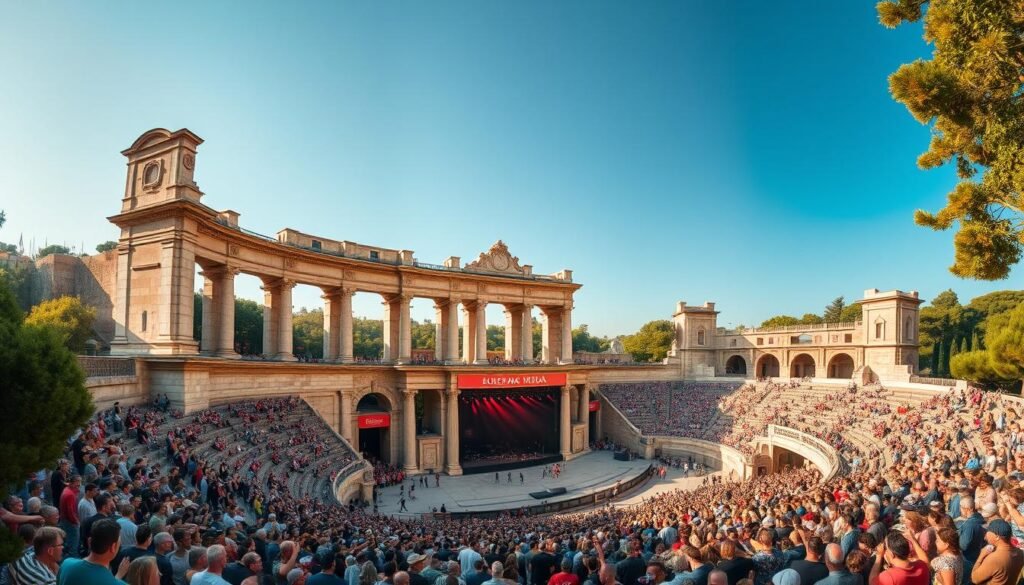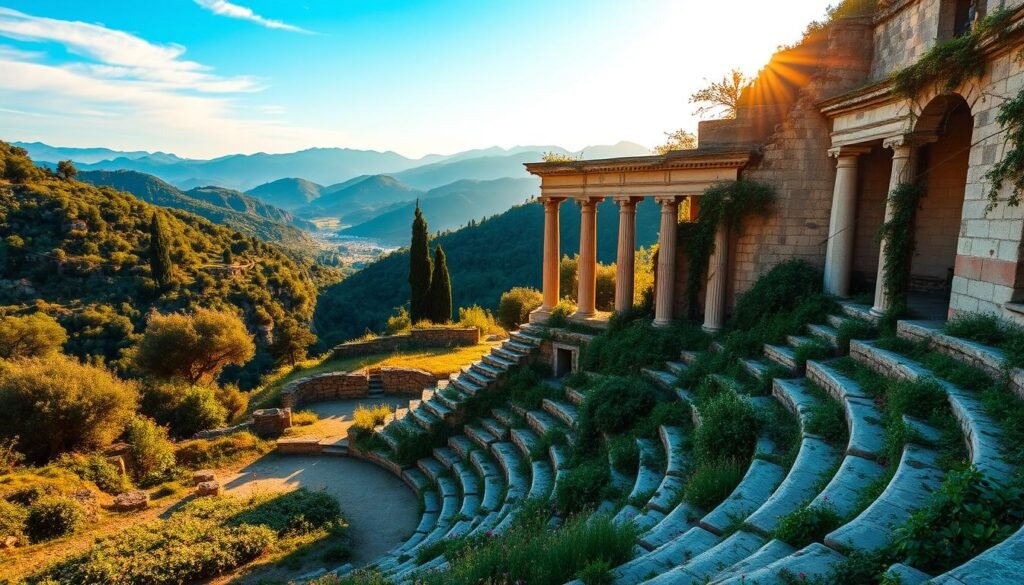Welcome to the fascinating world of ancient performance spaces. These places show us where history and art collide. The New York Times brings insights that highlight how these venues have influenced theater and architecture.
Through years, these spaces evolved, showing us their value in culture. They’ve made a big impact on today’s society. We will look into their unique traits. This reveals how they’ve shaped performing arts as we know it.
Key Takeaways
- Ancient performance spaces reveal insights into theatrical history and cultural practices.
- The architectural designs of ancient venues showcase innovation and creativity.
- Understanding these spaces helps us appreciate their role in modern performance arts.
- The New York Times provides valuable perspectives on the evolution of these ancient sites.
- Exploring ancient venues deepens our connection to human artistic expression.
The Allure of Ancient Performance Spaces
Ancient performance spaces were centers for cultural expression and community gatherings. They show the values and innovations of their times. Learning about their history helps us understand their role in entertainment and art.
Understanding Historical Context
Ancient performance venues tell us about the societies that built them. They were more than just places for entertainment. They reflected the political, social, and religious beliefs of their era. Each space has a story of community and cultural pride. Through them, we see how important performance arts were in society.
Key Characteristics of Ancient Venues
Ancient venues combined function and beauty. They had open-air amphitheaters and detailed theaters. These places showed the creativity of their builders. Key features included:
- Seating Arrangements: Seats were tiered so everyone could see well. This made sure all spectators were part of the show.
- Acoustic Design: Builders focused on acoustics for performers to be heard by all. They did this without the need for modern equipment.
- Decorative Elements: Venues were decorated with frescoes and sculptures. This added to the story being told, making performances more immersive.
These traits made ancient performances truly absorbing. They also influence today’s architecture, leaving a lasting impact.
| Characteristic | Description |
|---|---|
| Seating Arrangements | Tiered seating for optimal audience visibility |
| Acoustic Design | Natural sound amplification techniques |
| Decorative Elements | Visual art enhancing the thematic elements of performances |
Exploring Ancient Greek Theaters
Ancient Greek theaters are a tribute to ancient intelligence. They were built for plays and to reflect society and its values. These theaters also show off impressive architecture that had artistic and social purposes.
Architectural Marvels of the Era
The building style of these theaters shows the amazing architecture back then. Their best parts include:
- Semi-circular seating that makes sight and sound better
- A central area for the action to happen
- Detailed stages with backdrops and entrance areas
The Epidaurus theater is famous for its great sound and beautiful look. It attracts many who appreciate its design. These architectural feats show deep knowledge of beauty and function, earning them a place in history.
The Role in Cultural Heritage
Ancient Greek theaters were key to keeping culture alive. They were the stage for famous writers like Sophocles and Euripides. These places brought people together, helped society bond, and provided a space for discussion.
The impact of these theaters goes beyond their structure. They show the power of art and community in old times. They show how places for plays helped shape a shared culture. They still inspire today’s designs, marking their importance in our history.
Amphitheaters: Centers of Entertainment
Amphitheaters were the heart of fun in the old days. They held exciting events that everyone loved. These big buildings were more than just places to see things. They were where people came together. The design was smart, making sure lots of people could enjoy the shows.
Design and Construction Techniques
Building amphitheaters took real skill, and people still value this today. They used arches to make big spaces inside. This let everyone have a good view. They chose strong materials like concrete. This was to make sure these places lasted a long time. The oval shape helped make sounds louder, so everyone could hear the action.
Famous Examples from History
The Colosseum in Rome is really famous. It’s a big symbol of how skilled ancient builders were. It was huge and could fit thousands of people. It’s famous for the exciting fights that happened there. There are other famous ones too, like Pompeii’s and Nîmes’ amphitheaters. They show how important these buildings were in old times.

Outdoor Performance Venues and Their Significance
Outdoor venues were important in old cultures, acting as community hubs. They hosted seasonal shows and festivals, boosting cultural identity. With acoustic innovations, everyone could enjoy clear sound.
Acoustic Innovations in Ancient Times
Ancient creators used smart acoustic innovations in outdoor venues. They focused on:
- Sloping seats to help sound travel.
- Natural materials that made sound clearer.
- Choosing sites near water or hills to boost sound.
This made the listening experience better and the events more memorable.
Seasonal Performances and Festivals
Seasonal events were key for uniting communities. They celebrated farming, religion, and history. Highlights included:
- Harvest festivals with music and plays.
- Religious events with grand performances.
- Summer solstice with local talent on display.
These gatherings promoted togetherness and cultural heritage, making outdoor venues crucial.
Classical Architecture in Ancient Performance Spaces
Classical architecture has had a huge impact on old performance space designs. Its effects are seen in modern design today. Ancient buildings had designs that were both beautiful and significant. They showed the values of ancient cultures. To really appreciate today’s architecture, we need to understand this history.
Influence on Modern Design
Modern design is strongly influenced by classical architecture. Elements like columns and arches were used in old theaters and are now seen in new buildings. These designs are timeless, affecting both how buildings look and work. For example, many new auditoriums use old design ideas. They help with sound and make spaces nicer. Accessing modern venues with these designs helps us appreciate design changes.
Symbolism in Architectural Elements
Many design parts, like friezes, mean something important. They stand for power, culture, and shared values. In old theaters, these symbols showed how important art was. They still influence design today, aiming to inspire people. For instance, the American Academy of Arts and Letters design invites people to spaces full of history and meaning. It connects old and modern architecture and society.
Archaeological Sites of Theatrical History
Archaeological sites give us deep insights into theatrical history. These places, discovered by detailed digging, show us ancient performing arts. By exploring them, people learn about old buildings, how audiences were involved, and their cultural impact.
Major Excavation Discoveries
Many digs have found amazing things about old theaters. Some key findings are:
- The intact remains of the Theatre of Epidaurus in Greece, known for its extraordinary acoustics and capacity.
- The excavation of the Roman amphitheater in Pompeii, which reveals the societal role of public performances.
- Discoveries at the site of Delphi that illustrate the importance of theater in religious and social ceremonies.
Preserving Cultural Heritage through Archaeology
Archaeologists work hard to keep these sites safe. Their work saves both the buildings and the stories of past societies. By visiting these places, we feel a connection to history. It helps us value the development of theater.

Understanding Ancient Acoustics
Exploring ancient acoustics opens up how ancient cultures handled sound in their performance areas. These old theaters tapped into nature and smart design for better sound. This made it possible for sounds to travel, making performances deeply moving. The right acoustics were key for everyone to hear clearly, from voices to music, in big spaces.
How Sound Was Designed in Theaters
Sound design was crucial in the construction of old performance spaces. The designers looked at many things:
- Natural Landscapes: Using hills and open spaces helped carry sound further, reaching more people.
- Seating Arrangements: Rows of seats were arranged so sound could rise, making words easier to understand.
- Material Selection: Choosing various materials helped control how sound bounced around, for a better hearing experience.
The Science Behind Effective Acoustics
The creation of good acoustics in ancient theaters was based on physics principles. Important factors included:
- Sound Wave Behavior: Understanding the path of sound waves helped shape the design of spaces for performances.
- Echoes and Reverberation: Handling echoes and reverbs was vital for clear speech and music.
- Spatial Dynamics: How the audience was placed around the stage affected their listening experience from different spots.
Historical Entertainment: A Glimpse into the Past
Diving into historical entertainment opens a window to the past, where performances deeply influenced society. Ancient Greece and Rome showcased a mix of tragic, comedic, and dramatic performances. These not only entertained but also mirrored the cultural and political climates of the times.
Genres of Performance in Ancient Times
Back then, theaters were not just buildings; they were the cultural epicenters. They hosted a variety of performances, each reflecting the social and political air. Among them were:
- Tragedy: Tackling fate, suffering, and tough moral choices, tragedies made people think about life’s complexities.
- Comedy: With humor and satire, comedies often mocked societal norms and public figures, offering a unique perspective on society.
- Dramatic Readings: These showcased stunning language use and character depth, stirring deep emotions in the audience.
Social and Political Influence of Theater
Theater was more than entertainment; it was a reflection of society’s challenges and politics. Through plays, issues of the times were brought to light, influencing opinions and sparking involvement. People were drawn into discussions on governance, morals, and community values, all while being entertained.
Cultural Impact of Ancient Performance Space NYT
Exploring old theaters shows us how deeply they shape culture today. The New York Times tells us how old and new venues are alike and different. They show us that people always loved stories, no matter how much the world changes.
Comparative Studies of Ancient and Modern Venues
Ancient and modern theaters have a lot in common. They both aim to give people powerful experiences. The design of these places, from Greek amphitheaters to today’s theaters, is all about connecting the audience with the story.
Both old and new designs make sure viewers feel close to the action. This shows how well we’ve always known what makes a performance special.
Insights from NYT on Theatrical Evolution
The New York Times shows how theater has always changed, yet stayed the same at heart. By mixing old ways with new, today’s theater is vibrant and alive. This ongoing mix reminds us that new art can grow from knowing the past.